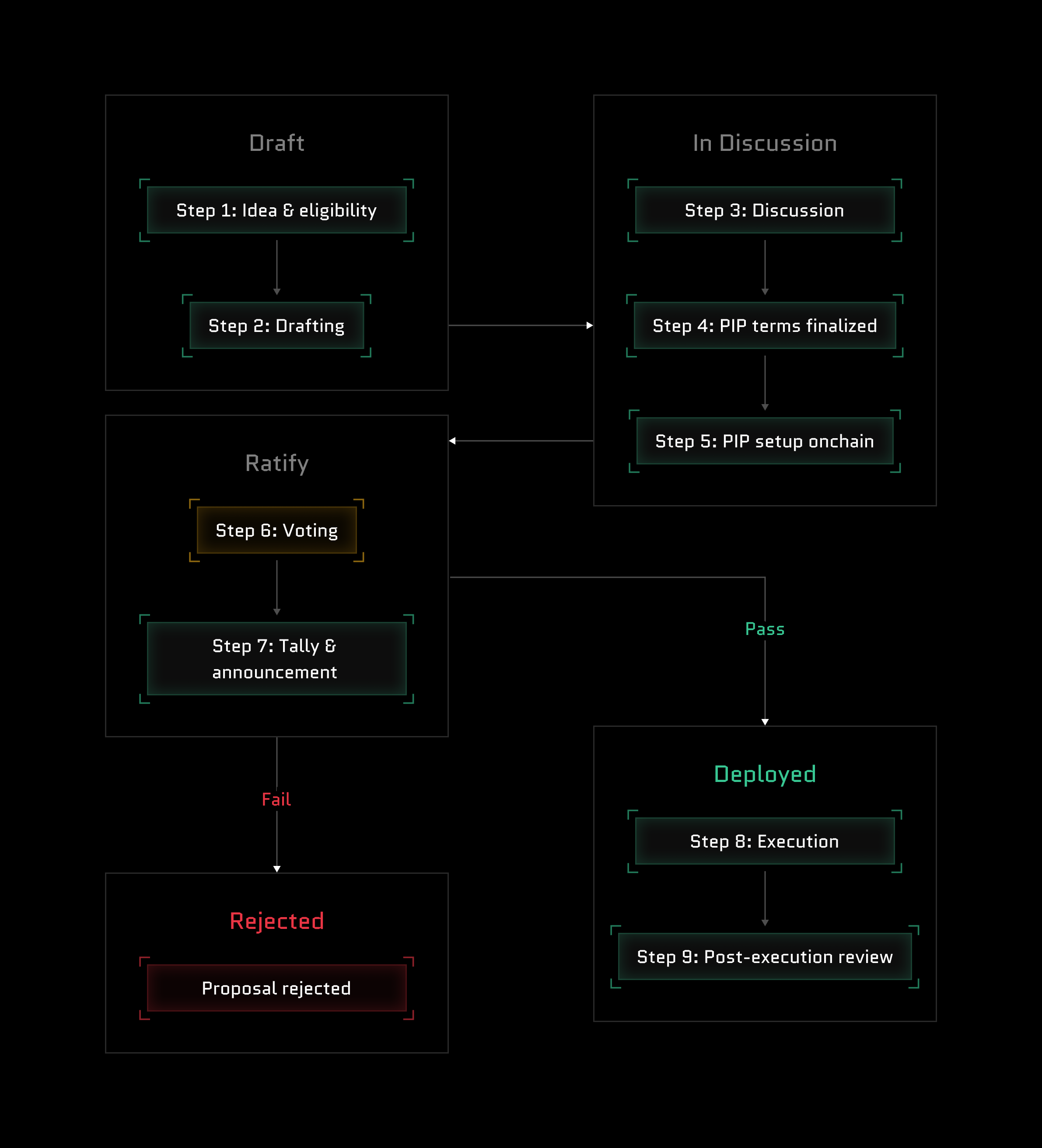NodeOps DAO
🌟 Status: Live
TL;DR
- $NODE stakers, bonders, and UNO holders are eligible to vote
- Protocol Improvement Proposals (PIPs) are discussed on Discourse and managed in GitHub
- PIPs are voted on in NodeOps Portal with outcomes recorded onchain
Overview
NodeOps Protocol governance is managed by a DAO that gives eligible participants control over the Protocol’s direction. The DAO can set key economic parameters, such as:
- Staking logic
- Emissions schedules
- Platform credit allocations
- Ecosystem grant disbursement
DAO governance shapes the Protocol's development.
Eligible participants
NodeOps applies a Proof of Coordination governance model that rewards those who contribute meaningfully.
This means that only those individuals who are actively involved in the staking, bonding, and who hold UNO have a vote, ensuring that decisions reflect real engagement and expertise.
- Standard participation: staked and bonded $NODE tokens carry equal voting weight (1 token = 1 vote).
- Universal Node Orchestrator (UNO) Operator participation: each UNO operator receives a voting weight of 2,000 $NODE tokens for every UNO NFT they hold.
Vote on governance proposals
Votes are cast by eligible participants in the NodeOps Portal app. Use the drop down for a voting guide.
Show me how to vote in NodeOps Portal
Prerequisites
- You are eligible to vote
- You are logged into NodeOps Portal app with the same Web3 wallet as you perform all your $NODE- and UNO-related activities
Voting guide
🚧 Status: Coming soon
Use the video or walkthrough to understand how to cast your vote on a Protocol Improvement Proposal.
- Logged into the Portal app, navigate to the Governance tab.
- Select a PIP that’s open for voting.
- Cast your vote, and click Submit Vote.
- Confirm in your wallet to register your vote onchain.
Congratulations, your vote is registered.
NodeOps DAO governance flow

Show me detailed governance flow
| Step | Description |
|---|---|
| 1. Idea & eligibility | DAO member identifies issue and checks if eligible to propose |
| 2. Drafting | Proposal is written (following the PIP guidelines) |
| 3. Discussion | Protocol improvement proposal posted on Discourse for feedback and refinement |
| 4. PIP finalization | Proposal updated based on feedback and prepared for voting |
| 5. PIP setup | Proposal submitted to Portal for onchain registration |
| 6. Voting | DAO members vote during the set window |
| 7. Tally & announcement | Results tallied, quorum checked, outcome announced |
| 8. Execution | Passed proposal is implemented |
| 9. Post-execution review | Community reviews and monitors implementation |
- Idea formation and eligibility.
A community member identifies an issue or improvement.
- Draft the proposal.
A proposal is drafted to be posted on Discourse. Either as a concept or as a PIP, following the required format and structure.
- Discussion on Discourse.
The proposal is posted on the NodeOps DAO’s Discourse forum for open discussion and feedback.
Typically, a 7-10 day discussion is encouraged. Community members debate and refine the proposal. If the proposal is already drawn up to format, the community may propose edits.
- Finalize the Proposal.
Incorporating the community feedback, the proposer drafts the PIP, following the required format and structure.
- PIP setup.
The proposal is submitted to Portal for onchain registration.
- Voting period runs.
The PIP defines its own voting window, typically between 3-21 days.
- Vote tallying and result announcement.
After the voting window closes, votes are tallied. Quorum requirements must be met for the vote to be valid. If quorum is not met, the proposal fails automatically.
- Execution.
If the proposal passes, the approved changes are implemented: Onchain actions are executed by smart contracts or DAO multisig, as applicable. Offchain actions are coordinated by the relevant working group or core team.
- Post-execution review.
The DAO monitors implementation and may discuss outcomes or suggest further improvements.
DAO FAQ
How do I get started?
To engage in governance, head over to Discourse to open up or join a discussion.
How do I create a PIP?
Fork the GitHub repo, github.com/NodeOps-app/pips and make your PR.
How does the DAO govern?
Protocol Improvement Proposals (PIPs) start life on Discourse as discussions or the GitHub repo and the link dropped in Discourse. If a PIP looks viable, a proposal is created and uploaded to NodeOps Portal. Finally, the DAO casts their votes and if the quorum is reached, the PIP will be enacted upon, or not, according to the outcome.
What next?
- Find the PIP template
- Learn more about NodeOps Protocol governance
- Learn more about the levers controlling the token economy